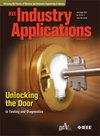On the Future of Micro Energy Control Unit (MECU) Integrated Grid
IF 4.5
2区 工程技术
Q2 ENGINEERING, ELECTRICAL & ELECTRONIC
引用次数: 0
Abstract
With promoting the application of renewable energy, distributed photovoltaic (PV) generation has become an important form of electrical source. More and more distributed PVs are connected into the power distribution system via traditional converters. With the continuous increase of PV penetration, the power grid is facing many challenges due to the inherent randomness and fluctuations of PV sources. Micro Energy Control Unit (MECU) is proposed as an alternative approach for the safe, economical, and efficient utilization of PV sources. Based on a multi-port structure, MECU connects photovoltaics, energy storage, the grid, and demand side loads. MECU can offer advantages of energy self-balancing, transient stability support, flexible demand-side integration, and power quality improvement. Two prototypes of MECU are developed for different application scenarios. Light-MECU is designed for small-capacity PV systems with strict space limits; The Modular Stackable Common-bus MECU (MSC-MECU) is used in high-power distributed PV grid-connected scenarios, such as rooftop PV systems. Experimental results show that MECU achieves energy self-balancing and transient stability support. MECU can be an effective solution for ensuring the reliable operation of power systems in the case of high PV penetration.论微能源控制单元(MECU)集成电网的未来
随着可再生能源应用的推进,分布式光伏发电已成为一种重要的电源形式。越来越多的分布式光伏电站通过传统的变流器接入配电系统。随着光伏发电普及率的不断提高,由于光伏发电源固有的随机性和波动性,电网面临着诸多挑战。微能量控制单元(MECU)是一种安全、经济、高效利用光伏发电的替代方法。基于多端口结构,MECU连接光伏、储能、电网和需求侧负载。MECU具有能量自平衡、暂态稳定支持、需求侧灵活集成、电能质量提升等优势。针对不同的应用场景,开发了两种MECU原型机。Light-MECU专为空间限制严格的小容量光伏系统设计;MSC-MECU (Modular Stackable Common-bus MECU)主要用于大功率分布式光伏并网场景,如屋顶光伏系统。实验结果表明,MECU实现了能量自平衡和暂态稳定支撑。在光伏高渗透率的情况下,MECU是保证电力系统可靠运行的有效解决方案。
本文章由计算机程序翻译,如有差异,请以英文原文为准。
求助全文
约1分钟内获得全文
求助全文
来源期刊

IEEE Transactions on Industry Applications
工程技术-工程:电子与电气
CiteScore
9.90
自引率
9.10%
发文量
747
审稿时长
3.3 months
期刊介绍:
The scope of the IEEE Transactions on Industry Applications includes all scope items of the IEEE Industry Applications Society, that is, the advancement of the theory and practice of electrical and electronic engineering in the development, design, manufacture, and application of electrical systems, apparatus, devices, and controls to the processes and equipment of industry and commerce; the promotion of safe, reliable, and economic installations; industry leadership in energy conservation and environmental, health, and safety issues; the creation of voluntary engineering standards and recommended practices; and the professional development of its membership.
 求助内容:
求助内容: 应助结果提醒方式:
应助结果提醒方式:


